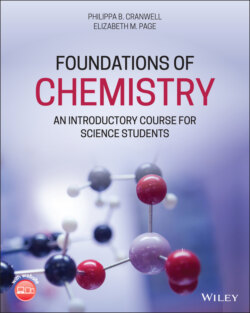Читать книгу Foundations of Chemistry - Philippa B. Cranwell - Страница 82
2.1.1 Atoms and molecules
ОглавлениеIn the first chapter, we saw that an atom is an individual entity that contains electrons, protons, and neutrons. A molecule is formed when two (or more) atoms bond together. Some elements exist naturally as molecules, such as chlorine, Cl2, nitrogen, N2, and hydrogen, H2. For example, Figure 2.1, shows eight hydrogen atoms and the four hydrogen molecules they form by bonding together.
Figure 2.1 (a) Eight hydrogen atoms; (b) four hydrogen molecules.
Atoms of different elements can also bond together to form molecules. When two or more elements are chemically joined together a compound is formed. Water, H2O, carbon dioxide, CO2, and ethanol, C2H5OH, are all examples of compounds.
An atom contains electrons, protons, and neutrons. A molecule is formed when two (or more) atoms bond together.
Within chemistry, there are three main ways in which atoms can bond together to make larger units. These bonding types are called metallic, ionic, and covalent. The first part of this chapter explains the different types of bonding that can occur and the types of compounds formed.
When considering bonding, the driving factor that causes an atom to lose or gain electrons is the extra stability the atom gains when it has a full outer shell of electrons. For example, the noble gases in Group 8 (Group 18) are especially stable because all of their orbitals are filled with electrons. Other atoms in the s and p blocks of the periodic table react by losing, gaining or sharing electrons in order to have the same electron configuration as the nearest noble gas element. This tendency of elements to attain a full outer shell of electrons is called the octet rule because the noble gases Ne and Ar have eight outer electrons.
The word octet is derived from the Latin for the number eight, which is octo. Hence the octet rule refers to eight electrons.
